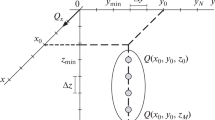Abstract
Even though the electrical activity of the heart varies very slowly with time, a complete and thorough investigation of the heart activity in terms of time-varying potentials and fields has been studied. Starting from Maxwell's equations in their vector partial differential equation form, a vector partial differential equation of the electric Hertzian vector potential\(\bar \Pi \) is set up in terms of the assumed electric dipole moment per unit volume of the electrical heart activityP. The equation is solved in terms of an infinite series in\(\bar \Pi \) and then approximated only to its first term since it converges extremely fast. The potential distribution inside the body ϕ, the electric field intensity\(\bar E\), and the magnetic field intensity\(\bar H\), are derived from\(\bar \Pi \) in terms of\(\bar P\). Thus ϕ,\(\bar E\) and\(\bar H\) are known in terms of\(\bar P\), the source.
Next, the inverse problem is investigated since it is of unique importance i.e. to determine\(\bar P\) knowing ϕ,\(\bar E\) or\(\bar H\). This is done in two different ways: the ‘electric’, ECG, and the ‘magnetic’, MCG. A comparison between the ECG and MCG follows and, finally, ways of determining\(\bar P\) ‘electrically’ and ‘magnetically’ are given.
Sommaire
Bien que l'activité électrique du coeur varie très lentement avec le temps, une étude complète et approfondie de l'activité cardiaque en fonction de potentiels et de champs variant avec le temps, a été étudiée. A partir des équations de Maxwell dans leur forme différentielle partielle de vecteur, une équation différentielle partielle de vecteur du potentiel de vecteur électrique Hertzien\(\bar \Pi \) est établie en fonction du moment dipolaire électrique supposé par unité de volume de l'activité électrique du coeur\(\bar P\). L'équation est résolue en termes d'une série infinie en\(\bar \Pi \) et ensuite une approximation est faite à son premier terme puisqu'il est d'une convergence très rapide. La répartition de potentiel dans le corps ϕ, l'intensité du champ électrique\(\bar E\) et l'intensité du champ magnétique\(\bar H\) sont dérivés de\(\bar \Pi \) en termes de\(\bar P\). Ainsi ϕ\(\bar E\) et\(\bar H\) sont connus en termes de\(\bar P\), la source.
Ensuite, le problème inverse est étudié car il est d'importance unique, c'est à dire la détermination de\(\bar P\) connaissant ϕ\(\bar E\) ou\(\bar H\). Deux méthodes sont utilisées: celle ‘électrique’ ECG et celle ‘magnétique’ MCG. Une comparaison est faite entre ECG et MCG et finalement on donne les moyens de déterminer\(\bar P\) ‘électriquement’ et ‘magnétiquement’.
Zusammenfassung
Obgleich sich die elektrische Tätigkeit des Herzens nur sehr langsam mit der Zeit ändert, hat man eine vollständige und gründliche Untersuchung der Herztätigkeit in Form von zeitlich veränderlichen Potentialen und Feldern studiert. Mit den Maxwell'schen Gleichungen in Form ihrer partiellen Vektordifferentialgleichungen beginnend, wird eine partielle Vekordifferentialgleichung des Hertz'schen elektrischen Vektorpotentials\(\bar \Pi \) in Form des angenommenenen elektrischen Dipolmoments pro Raumeinheit der elektrischen HerztätigkeitP aufgestellt. Die Gleichung wird in Form einer unendlichen Reihe in\(\bar \Pi \) gelöst und dann nur auf ihren ersten Ausdruck approximiert, da sie sich äusserst schnell ihrem Grenzwert nähert. Die Potentialverteilung innerhalb des Körpers ϕ, die elektrische Feldintensität\(\bar E\) und die magnetische Feldintensität\(\bar H\) werden aus\(\bar \Pi \) in Form von\(\bar P\) abgeleitet. Somit sind ϕ,\(\bar E\) und\(\bar H\) in Form von\(\bar P\), der Quelle, bekannt.
Danach wird das umgekehrte Problem untersucht, da es von einzigartiger Bedeutung ist, d.h.\(\bar P\) zu bestimmen, wenn,\(\bar E\) oder\(\bar H\) bekannt sind. Dies wird in zwei verschiedenen Weisen getan: der ‘elektrischen’, EKG, und der ‘magnetischen’ MKG. Es folgt ein Vergleich zwischen dem EKG und MKG und zum Abschluss folgen Wege, um\(\bar P\) ‘elektrisch’ und ‘magnetisch’ ermitteln zu können.
Similar content being viewed by others
References
Barr, R. C., Pilkington, T. C., Boineau, J. P. andSpach, M. S. (1966) Determining surface potentials from current dipoles with application to electrocardiography.IEEE Trans. bio-med. Engng BME-13, 88–92.
Baule, G. M. andMcFree R. (1970) The magnetic heart vector.Am. Heart J. 79, 223–236.
Cohen, D. (1969) Detection and analysis of magnetic fields produced by bioelectric currents in humans.J. appl. Phys. 40, 1046–1048.
Cohen, D. (1970) Review of measurements of magnetic fields produced by natural ion currents in humans.IEEE Trans. Magnet. MAG-6, 344.
Gabor, D. andNelson, C. V. (1954) Determination of the resultant dipole of the heart from measurements of the body surface.J. appl. Phys. 25, 413–416.
Geselowitz, D. B. (1960) Multipole representation for an equivalent cardiac generator.Proc. IRE 48, 75–79.
Geselowitz, D. B. (1965) Two theorems concerning the quadrupole applicable to electrocardiography.IEEE Trans. bio-med. Engng BME-12, 164–168.
Statton, J. A. (1941)Electromagnetic Theory. McGraw-Hill, New York.
Taccardi, B. (1963) Distribution of heart potentials on the thoracic surface of normal human subjects.Circulation Res. 12, 341.
Author information
Authors and Affiliations
Rights and permissions
About this article
Cite this article
Paraskevopoulos, P.N. Determination of heart dipole vector\(\bar P\) ‘electrically’ and ‘magnetically’. Comparison‘electrically’ and ‘magnetically’. Comparison. Med. & biol. Engng. 9, 645–655 (1971). https://doi.org/10.1007/BF02474645
Received:
Issue Date:
DOI: https://doi.org/10.1007/BF02474645




